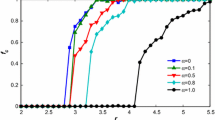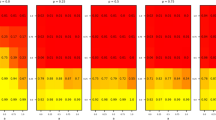Abstract
Collective action in the provision of pubic goods is analyzed in the framework of three kinds of public goods dilemmas routinely encountered in real-life situations. We study the evolution of cooperation in structured populations within three PGG models: the traditional public goods game (PGG), complementary public goods game (PPGG) and containable public goods game (TPGG), differing in supplying patterns of public goods. In addition, we extend the combination of dual strategy (cooperation and defection) to a portfolio of multiple strategies. We reveal that, is a fundamental property promoting cooperation in groups of selfish individuals, irrespective of which social dilemma applies. For a parallel comparison, it is found that the system in PGG and PPGG can perform comparatively better than TPGG, which reduces the provision of the public goods. Our study can be helpful in effectively portraying the characteristics of cooperative dilemmas in real social systems.
Similar content being viewed by others
References
Smith, J.: Evolution and the Theory of Games. Cambridge University Press, Cambridge (1982)
Nowak, M.A., Sigmund, K.: Phage-lift for game theory. Nature 399, 367–368 (1999)
Cleary, A.S., Leonard, T.L., Gestl, S., Gunther, E.: Tumour cell heterogeneity maintained by cooperating subclones in Wnt-driven mammary cancers. Nature 508(7494), 113–117 (2014)
Xu, Z., Zhang, J., Zhang, C., Chen, Z.: Fixation of strategies driven by switching probabilities in evolutionary games. EPL (Europhys. Lett.) 116(5), 58002 (2017)
Ramazi, P., Riehl, J., Cao, M.: Networks of conforming or nonconforming individuals tend to reach satisfactory decisions. Proc. Natl. Acad. Sci. 113(46), 12985–12990 (2016)
Choi, W., Yook, S.H., Kim, Y.: Percolation in spatial evolutionary prisoner’s dilemma game on two-dimensional lattices. Phys. Rev. E 92(5) (2015)
Zhang, J., Zhang, C., Chu, T.: Cooperation enhanced by the survival of the fittest’ rule in prisoner’s dilemma games on complex networks. J. Theor. Biol. 267, 41–47 (2010)
Ghoneim, A., Abbass, H., Barlow, M.: Characterizing game dynamics in two-player strategy games using network motifs. IEEE Trans. Syst. Man Cybern. 38, 682–690 (2008)
Zhao, J., Szilágyi, M., Szidarovszky, F.: An n-person battle of sexes game. Phys. A 387, 3669–3677 (2008)
Chan, C.H., Yin, H., Hui, P.M., Zheng, D.F.: Evolution of cooperation in well-mixed \(n\)-person snowdrift games. Phys. A 387, 2919–2925 (2008)
Pacheco, J.M., Santos, F.C., Souza, M.O., Skyrms, B.: Evolutionary dynamics of collective action in \(n\)-person stag hunt dilemmas. Proc. R. Soc. Lond. B 276, 315–321 (2009)
Vamvoudakis, K.G., Hespanha, J.P.: Online optimal operation of parallel voltage-source inverters using partial information. IEEE Trans. Industr. Electron. 64(5), 4296–4305 (2017)
Wang, J., Hipel, K.W., Fang, L., Xu, H., Kilgour, D.M.: Behavioral analysis in the graph model for conflict resolution. IEEE Trans. Syst. Man Cybern.: Syst. (2017)
Wedekind, C., Milinski, M.: Cooperation through image scoring in humans. Science 288, 850–852 (2000)
Nowak, M.A.: Five rules for the evolution of cooperation. Science 314, 1560–1563 (2006)
Groot, N., De Schutter, B., Hellendoorn, H.: On systematic computation of optimal nonlinear solutions for the reverse stackelberg game. IEEE Trans. Syst. Man Cybern.: Syst. 44(10), 1315–1327 (2014)
Shahrivar, E.M., Sundaram, S.: The strategic formation of multi-layer networks. IEEE Trans. Netw. Sci. Eng. 2(4), 164–178 (2015)
Nowak, M.A., May, R.M.: Evolutionary games and spatial chaos. Nature 359, 826–829 (1992)
Weitz, J.S., Eksin, C., Paarporn, K., Brown, S.P., Ratcliff, W.C.: An oscillating tragedy of the commons in replicator dynamics with game-environment feedback. Proc. Natl. Acad. Sci. 113(47), E7518–E7525 (2016)
Zhang, C., Zhang, J., Xie, G., Wang, L.: Coevolving agent strategies and network topology for the public goods games. Eur. Phys. J. B 80, 217–222 (2011)
Zhang, J., Zhang, C., Cao, M., Weissing, F.: Crucial role of strategy updating for coexistence of strategies in interaction networks. Phys. Rev. E 91(4), 042101 (2015)
Hauert, C., De Monte, S., Hofbauer, J., Sigmund, K.: Volunteering as Red Queen mechanism for cooperation in public goods game. Science 296, 1129–1132 (2002)
Kümmerli, R., Burton-Chellew, M.N., Ross-Gillespie, A., West, S.A.: Resistance to extreme strategies, rather than prosocial preferences, can explain human cooperation in public goods games. Proc. Natl. Acad. Sci. USA 107, 10125–10130 (2010)
Santos, F.C., Santos, M.D., Pacheco, J.M.: Social diversity promotes the emergence of cooperation in public goods games. Nature 454, 213–216 (2008)
Acknowledgments
This work was supported by the National Natural Science Foundation of China (Grant Nos. 61603199, 61603201 and 61573199), and the Foundation of Key Laboratory of Machine Intelligence and Advanced Computing of the Ministry of Education (Grant No. MSC-201709A).
Author information
Authors and Affiliations
Corresponding author
Editor information
Editors and Affiliations
Rights and permissions
Copyright information
© 2017 Springer International Publishing AG
About this paper
Cite this paper
Xu, Z., Li, Q., Zhang, J. (2017). Collective Actions in Three Types of Continuous Public Goods Games in Spatial Networks. In: Liu, D., Xie, S., Li, Y., Zhao, D., El-Alfy, ES. (eds) Neural Information Processing. ICONIP 2017. Lecture Notes in Computer Science(), vol 10638. Springer, Cham. https://doi.org/10.1007/978-3-319-70139-4_69
Download citation
DOI: https://doi.org/10.1007/978-3-319-70139-4_69
Published:
Publisher Name: Springer, Cham
Print ISBN: 978-3-319-70138-7
Online ISBN: 978-3-319-70139-4
eBook Packages: Computer ScienceComputer Science (R0)




